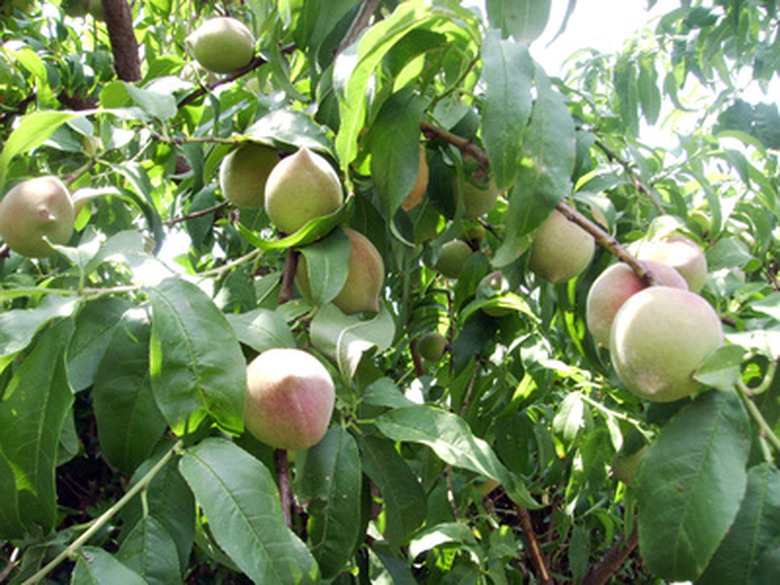How To Plant And Care For A Peach Tree In Tennessee
Things Needed
- Sulfur
- Shovel
- Peach sapling
- Fertilizer (12-12-12)
- Anvil pruners
- White latex paint
- Paintbrush
While peaches grow well in Tennessee, you will have to provide slight winter protection and will need to regularly care for the peach tree to maintain a healthy, fruiting tree. Peaches ripen in late summer in Tennessee, typically in July and August. Varieties of yellow peaches recommended for Tennessee include Surecrop, Redhaven, Sunhigh, Elberta and Loring. The Georgia Belle is a white-fleshed peach that fares well in Tennessee.
Step 1
Choose a location that receives full sun in March or April, the recommended time to plant a peach in Tennessee. Test the soil using a pH kit or call your local county extension to schedule a soil test. Peaches prefer a soil pH of 6 to 6.5, which is slightly acidic.
- While peaches grow well in Tennessee, you will have to provide slight winter protection and will need to regularly care for the peach tree to maintain a healthy, fruiting tree.
Step 2
Add 1.2 oz. of sulfur per square yard to a sandy soil and 3.6 oz. sulfur per square yard to other soils to lower the pH by one point. Work the sulfur into the soil by turning it over with a shovel.
Step 3
Dig a hole as deep as the peach sapling's container and two to three times as wide as the container. Roughen up the soil at the bottom of the hole by jabbing it with your shovel. Remove any sticks, stones, weeds or roots in the hole so your peach tree won't have competition.
- of sulfur per square yard to a sandy soil and 3.6 oz.
- Work the sulfur into the soil by turning it over with a shovel.
Step 4
Remove the peach tree from its container. Untangle any curled roots and break apart the root ball by massaging it with your fingers. Tangled roots can choke and kill the peach tree, so spread them out with your fingers.
Step 5
Place the peach tree in the hole at the same depth as it was planted. Spread the roots out in the soil. Backfill the hole with dirt.
Step 6
Water the newly planted peach tree until the soil becomes saturated and compresses around the plant roots. The University of Missouri recommends using 1 to 2 gallons of water.
- Remove the peach tree from its container.
- Tangled roots can choke and kill the peach tree, so spread them out with your fingers.
Continue to water your Tennessee peach tree. According to the University of Georgia, mature trees (six years and older) need 125 gallons of water per week, which is equal to 1 inch of rainfall. Younger trees should receive 6 gallons of water per every foot of diameter of the tree canopy. So a tree with a 10-foot spread would need 60 gallons of water per week.
Step 7
Cut any limbs on your newly planted peach tree back to 1 inch just after planting. Allow the peach tree to grow until the summer, then prune away any suckers that grow off the tree trunk or from the graft site.
Step 8
Scatter 1/2 cup of 12-12-12 fertilizer around the base of your peach tree one month after planting. Water the fertilizer to work it into the soil.
- Continue to water your Tennessee peach tree.
- Scatter 1/2 cup of 12-12-12 fertilizer around the base of your peach tree one month after planting.
In subsequent years, apply 1 to 2 lb. of 12-12-12 fertilizer for each year of age in the early spring, before the peach has begun growing for the season. So a three-year-old peach tree would receive 3 to 6 lbs. of 12-12-12 fertilizer.
Step 9
Prune the young peach again in June of the first year, a few months after planting. Select three to four string limbs (evenly spaced around the tree) and cut off all competing limbs. Then cut back the trunk so it is three to four inches above these branches.
- In subsequent years, apply 1 to 2 lb.
- Prune the young peach again in June of the first year, a few months after planting.
Step 10
Paint the bottom 24 inches of your peach tree trunk with white interior-grade latex paint. This prevents peach trees from sun scald and prevents winter injury in Tennessee peach trees. Apply the paint in the late fall, on a warm day.
Step 11
Prune the peach tree again in late winter once frost danger has passed. Remove competing limbs as you did in June. Trim off one-third of the growth on your scaffold or main limbs to promote branching. Remove suckers and any limbs growing toward the trunk or parallel to the trunk.
- Paint the bottom 24 inches of your peach tree trunk with white interior-grade latex paint.
- Prune the peach tree again in late winter once frost danger has passed.
